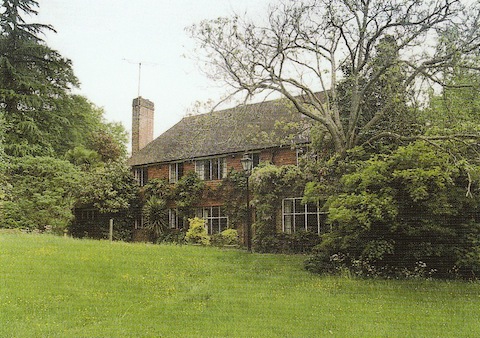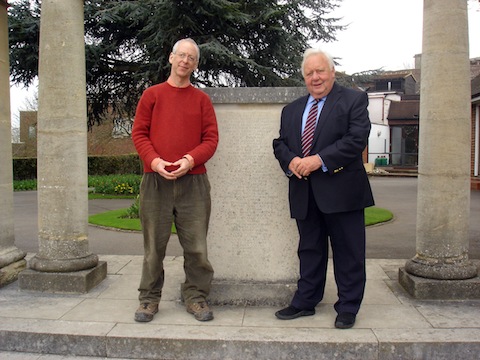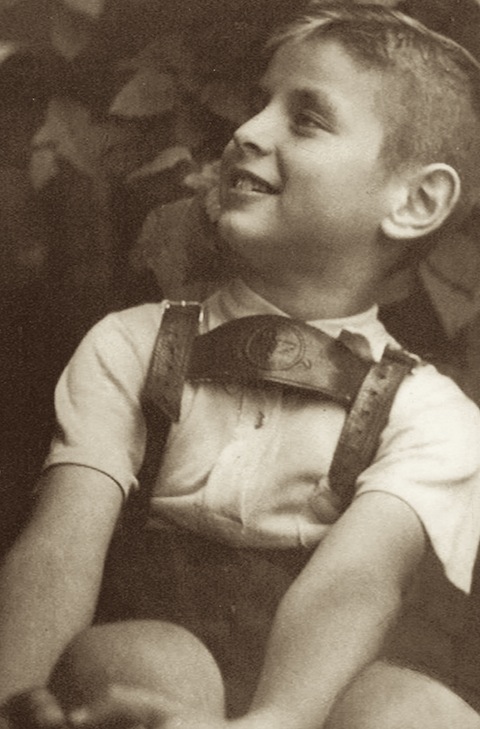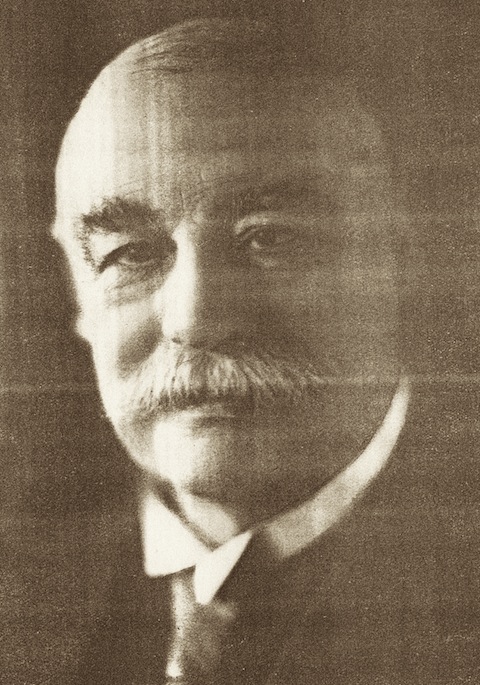 Abraham Lincoln
If given the truth, the people can be depended upon to meet any national crisis...
Abraham Lincoln
If given the truth, the people can be depended upon to meet any national crisis...
 Guildford news...
for Guildford people, brought to you by Guildford reporters - Guildford's own news service
Guildford news...
for Guildford people, brought to you by Guildford reporters - Guildford's own news service
Do You Recall A German Boy Who Came To Guildford As A Wartime Refugee?
Published on: 28 Apr, 2013
Updated on: 30 Apr, 2013
By David Rose
Does any reader who was in Guildford at the time of World War II remember a lad by the name of Kurt Rosenfeld? If so, his nephew would be pleased to hear from you.
Born in 1929, Kurt was a German-Jewish boy who, at the age of 10, arrived here from Nazi Germany in August 1939 as a kindertransport refugee. This was a rescue mission that took place just before the war. Nearly 10,000 predominantly Jewish children from Nazi Germany, Austria, Czechoslovakia, Poland and the Free City of Danzing, came to the UK.
Many of these refugees were placed in foster homes or on farms, but Kurt was taken in by a kindly elderly couple, Major and Mrs Shelley, who lived first at Hitherbury (off Portsmouth Road), then at Fieldplot (Flower Walk), both in Kurt’s time with the Shelleys.
When he arrived Kurt could not speak English, but he soon adjusted to the Guildford way of life becoming a member of a local scout troop and a keen rugby player.
Andrew Schindel is Kurt’s nephew. He is currently in the UK on a visit from his home in Maine in the USA, keen to find out as much as he can about his uncle’s time in Guildford.
Were you at school with Kurt? It is not known which one he attended. It could have been St Nicolas, Holy Trinity or Ludlow Road.
It’s believed Kurt was a scout, could he have been in the 9th Guildford troop that used to meet at Centenary Hall, Chapel Street?
A boy from Germany who was just beginning to learn English must have stood out at the time. Do you recall someone like that?
Andrew would very much like to hear from anyone who knew his uncle or might have further information on Major and Mrs Shelley and their daughter Hilary.
It is likely Major Shelley served overseas. Andrew has some details that the major was also an engineer and worked for an Indian railway company at some stage.
Mrs Shelley was a dedicated church woman who annually sponsored Christmas parties at Guildford’s Salvation Army citadel, which was then in Laundry Road.
Does anyone remember them in Guildford? Major Shelley was a keen plantsman who specialised in roses. Perhaps there are readers who had relatives who were once in service at Hitherbury or Fieldplot, either in the house or working in the garden.

The house Fieldplot, from a sales brochure issued by estate agents Clarke Gammon. The Shelleys had this house built for them.
He would also welcome the opportunity to speak to anyone who would be able to give him more information on life on the Home Front in Guildford between 1939-45. He has seen a copy of my book Guildford The War Years 1939-45 (co-written with Graham Collyer), so has a good idea of what Guildford was like during wartime, but he says he likes to talk to people and to hear their memories and stories.
Andrew Schindel may be contacted via his email address andrew.schindel@gmail.com or on his English mobile phone number 07936 986 615.
I am giving my popular illustrated talk, Guildford The War Years, to an afternoon group from St Nicolas’ Church that meets in the hall there this Thursday, May 2. Andrew is coming along to hear the talk and I will add some details about Kurt into it that afternoon.

Andrew Schindel (left) pictured with Alderman (and war child) Bernard Parke in front of Guildford’s war memorial in the Castle Grounds. They met up with the former curator of Guildford Museum, Matthew Alexander, to talk about the town during 1939-45.
Callers with detail about Kurt or the Shelleys may also like to contact me, David Rose, on 01483 838960, email drosedragon@gmail.com
But what happened to Kurt after the war? His story continues to be rather fascinating. Andrew told me that Major Shelley was a keen photographer and had a darkroom at his home. He taught Kurt some photographic skills and Kurt then became interested in mechanics and engineering.
Through the Jewish Refugee Service, Kurt left Guildford for a job in London and worked for the lighting company Osram. This was after the war had ended and Kurt was aged 16. But after several years he became quite disillusioned with this work, seeing no future in it for him. He was taking dancing lessons (mainly as a way of finding a girl), and was soon quite an accomplished dancer. He entered competitions and became a dance instructor. Excuse the pun, but he’d fallen on his feet, so to speak!
With this new found direction, Kurt decided to officially change his name, fully embracing the English way of life, and so he became Kenneth Rapley.
However, there were more changes to come, as in 1956 he left the UK to make a new life in the USA. There he married and lived in Washington DC.
Kenneth’s sister Lotte (Andrew’s mother) was also a refugee, but she came to London during the war by a private arrangement. Their father had died before the war. Kurt and Lotte were not to see their mother again: in March 1942 she was deported to the Lublin district of eastern Poland and to the Piaski Ghetto and Trawniki work camp, after which her fate is sadly not known.
Andrew’s mother also made a life in the USA and Andrew knew his uncle well. Originally called Kurt, but known to friends and family in the States as Ken, he passed away last year aged 83.
Responses to Do You Recall A German Boy Who Came To Guildford As A Wartime Refugee?
Leave a Comment Cancel replyPlease see our comments policy. All comments are moderated and may take time to appear. Full names, or at least initial and surname, must be given.
Recent Articles
- Insights: The Band on the Titanic Strikes Up ‘Devolution!’ – Part 3
- Insights: The Band on the Titanic Strikes Up ‘Devolution!’ – Part 2
- GBC to Receive No Additional Money from Announced Settlement
- Woking Looking for Someone to Take On Victorian Hall
- Letter: A Surge of Discontent Calls for Accountability and Change
- Insights: The Band on the Titanic Strikes Up ‘Devolution!’ – Part 1
- Letter: Benefits of New Ash Bridge Are Dubious
- Letter: Unitary Authorities Will Allow More Coherent Planning
- Emergency Work on Embankment to Reopen Guildford to Effingham Line
- Letter: Twas the Night Before Christmas…


Recent Comments
- Derek Payne on Letter: Guildford Can’t Be Trusted with E-Bikes for Hire
- Elle Hepburn on Student Named Land Based and Horticulture Learner of the Year
- John Ferns on Letter: Benefits of New Ash Bridge Are Dubious
- David Roberts on Insights: The Band on the Titanic Strikes Up ‘Devolution!’ – Part 2
- Ben Paton on Insights: The Band on the Titanic Strikes Up ‘Devolution!’ – Part 1
- Roger Kendall on Letter: Benefits of New Ash Bridge Are Dubious
Search in Site
Media Gallery
Dragon Interview: Local Artist Leaves Her Mark At One of England’s Most Historic Buildings
January 21, 2023 / No Comment / Read MoreDragon Interview: Lib Dem Planning Chair: ‘Current Policy Doesn’t Work for Local People’
January 19, 2023 / No Comment / Read MoreA3 Tunnel in Guildford ‘Necessary’ for New Homes, Says Guildford’s MP
January 10, 2023 / No Comment / Read More‘Madness’ for London Road Scheme to Go Ahead Against ‘Huge Opposition’, Says SCC Leader
January 6, 2023 / No Comment / Read MoreCouncillor’s Son Starts Campaign for More Consultation on North Street Plan
December 30, 2022 / No Comment / Read MoreCounty Council Climbs Down Over London Road Works – Further ‘Engagement’ Period Announced
December 14, 2022 / No Comment / Read MoreDragon Interview: GBC Reaction to the Government’s Expected Decision to Relax Housing Targets
December 7, 2022 / No Comment / Read MoreHow Can Our Town Centre Businesses Recover? Watch the Shop Front Debate
May 18, 2020 / No Comment / Read More













Ray Springer
April 30, 2013 at 2:54 pm
I cannot remember any German lad, although I was at Ludlow Road School from 1940 – 1944. I was also a boy scout at the 9th Guildford troop in Chapel Street probably about 1946 – 47 or so.
No help really but an interesting story – he was only six years older than me.
Martin Shelley
May 27, 2013 at 6:02 pm
Archibald Shelley was my great uncle and, yes, he did serve overseas. He was in the Royal Engineers and served in India both in the army and in the Bombay Baroda and Central Indian Railways. He retired before the end of WW1 and went to live in Guildford,
I remember Hilary – just – but not him or his wife Hilda.
C.S. Sundaram
April 27, 2014 at 10:51 pm
Hello from Canada. This is a reply to Martin Shelley. Your great uncle also worked as an Agent for the South Indian Railways, at least in 1898. I know this because my great grandfather, a Mr. G. Rama Iyer, worked under him! I have a power of attorney, signed by Captain ADG Shelley, RE, which bestowed upon Rama Iyer, at that time a railway inspector, the authority to represent the South Indian Railways in civil and criminal proceedings. The document is dated Trichinopoly 19 May 1898. I have a jpeg of the original document, and could easily send it. Small world, eh?
best,
Chandar S. Sundaram,
writer, historian, educator, editor,
Victoria, BC, Canada
Michael Wood
March 31, 2016 at 2:34 pm
Thanks belatedly for the interesting article David and to Martin Shelley and Chandar Sundaram for their replies. A bit late in the day, this, but still.
Archibald (A.D.G) Shelley was also a keen and skilled photographer who took a series of wonderful images of South Indian temple architecture for the Illustrated South Indian Railway Guide published in Madras (as was) in 1900 and later editions.
Many of these can be seen online eg at: https://commons.wikimedia.org/wiki/Category:A.D.G._Shelley
One of the places he photographed was the famous Nataraja temple at Chidambaram. I am trying to put together an account of this shrine and the changes to its structures in the last 150 years. I would love to locate any other images by ADGS.
I’d be very grateful if anyone knows what happened to Archibald’s negatives. Did he bring them back to Guildford? Did he deposit them with an institution here? Or did they stay in India?